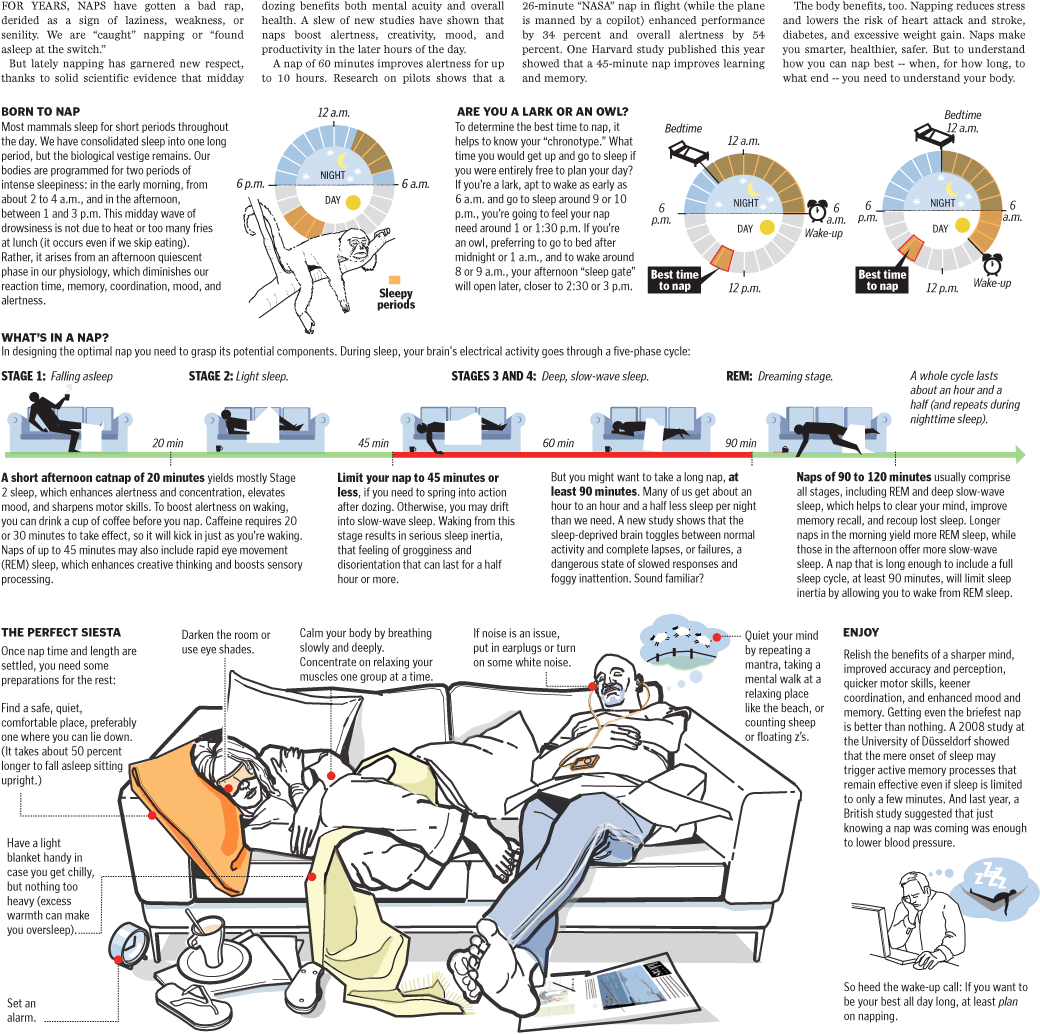
How to Nap
FOR YEARS, NAPS have gotten a bad rap, dozing benefits both mental acuity and overall derided as a sign of laziness, weakness, or senility. We are "caught" napping or "found asleep at the switch." But lately napping has garnered new respect, thanks to solid scientific evidence that midday The body benefits, too. Napping reduces stress is manned by a copilot) enhanced performance and lowers the risk of heart attack and stroke, by 34 percent and overall alertness by 54 diabetes, and excessive weight gain. Naps make percent. One Harvard study published this year you smarter, healthier, safer. But to understand A nap of 60 minutes improves alertness for up showed that a 45-minute nap improves learning how you can nap best -- when, for how long, to what end -- you need to understand your body. 26-minute "NASA" nap in flight (while the plane health. A slew of new studies have shown that naps boost alertness, creativity, mood, and productivity in the later hours of the day. to 10 hours. Research on pilots shows that a and memory. BORN TO NAP 12 a.m. ARE YOU A LARK OR AN OWL? Bedtime 12 a.m. Most mammals sleep for short periods throughout the day. We have consolidated sleep into one long period, but the biological vestige remains. Our bodies are programmed for two periods of intense sleepiness: in the early morning, from about 2 to 4 a.m., and in the afternoon, between 1 and 3 p.m. This midday wave of drowsiness is not due to heat or too many fries at lunch (it occurs even if we skip eating). Rather, it arises from an afternoon quiescent phase in our physiology, which diminishes our reaction time, memory, coordination, mood, and alertness, To determine the best time to nap, it helps to know your "chronotype." What time you would get up and go to sleep if you were entirely free to plan your day? If you're a lark, apt to wake as early as 6 a.m. and go to sleep around 9 or 10 p.m., you're going to feel your nap need around 1 or 1:30 p.m. If you're an owl, preferring to go to bed after midnight or 1 a.m., and to wake around 8 or 9 a.m., your afternoon "sleep gate" Best time will open later, closer to 2:30 or 3 p.m. Bedtime 12 a.m. NIGHT бр.т. -6 a.m. DAY NIGHT NIGHT 6. a.m. 6. 96 a.m. p.m. Wake-up р.т. DAY DAY Best time to nap to nap 12 p.m. 12 p.m. Wake-up Sleepy periods WHAT'S IN A NAP? In designing the optimal nap you need to grasp its potential components. During sleep, your brain's electrical activity goes through a five-phase cycle: STAGE 1: Falling asleep STAGE 2: Light sleep. STAGES 3 AND 4: Deep, slow-wave sleep. REM: Dreaming stage. A whole cycle lasts about an hour and a half (and repeats during nighttime sleep). 20 min 45 min 60 min 90 min Limit your nap to 45 minutes or less, if you need to spring into action after dozing. Otherwise, you may drift into slow-wave sleep. Waking from this A short afternoon catnap of 20 minutes yields mostly Stage 2 sleep, which enhances alertness and concentration, elevates mood, and sharpens motor skills. To boost alertness on waking, you can drink a cup of coffee before you nap. Caffeine requires 20 or 30 minutes to take effect, so it will kick in just as you're waking. Naps of up to 45 minutes may also include rapid eye movement (REM) sleep, which enhances creative thinking and boosts sensory processing. But you might want to take a long nap, at least 90 minutes. Many of us get about an hour to an hour and a half less sleep per night than we need. A new study shows that the sleep-deprived brain toggles between normal activity and complete lapses, or failures, a dangerous state of slowed responses and foggy inattention, Sound familiar? Naps of 90 to 120 minutes usually comprise all stages, including REM and deep slow-wave sleep, which helps to clear your mind, improve memory recall, and recoup lost sleep. Longer naps in the morning yield more REM sleep, while those in the afternoon offer more slow-wave sleep. A nap that is long enough to include a full sleep cycle, at least 90 minutes, will limit sleep inertia by allowing you to wake from REM sleep. stage results in serious sleep inertia, that feeling of grogginess and disorientation that can last for a half hour or more. THE PERFECT SIESTA Calm your body by breathing slowly and deeply. Concentrate on relaxing your muscles one group at a time. Darken the room or ENJOY If noise is an issue, put in earplugs or turn on some white noise. Quiet your mind by repeating a mantra, taking a mental walk at a relaxing place like the beach, or counting sheep or floating z's. use eye shades. Once nap time and length are settled, you need some preparations for the rest: Relish the benefits of a sharper mind, improved accuracy and perception, quicker motor skills, keener coordination, and enhanced mood and memory. Getting even the briefest nap is better than nothing. A 2008 study at the University of Düsseldorf showed that the mere onset of sleep may trigger active memory processes that remain effective even if sleep is limited to only a few minutes. And last year, a British study suggested that just knowing a nap was coming was enough to lower blood pressure. Find a safe, quiet, comfortable place, preferably one where you can lie down. (It takes about 50 percent longer to fall asleep sitting upright.) Have a light blanket handy in case you get chilly, but nothing too heavy (excess warmth can make you oversleep). Set an alarm. So heed the wake-up call: If you want to be your best all day long, at least plan on napping.
How to Nap
Source
Unknown. Add a sourceCategory
HealthGet a Quote






